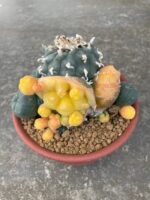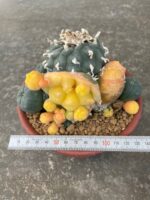-52%New





This extraordinary specimen of Peyote (Lophophora williamsii Variegata) buttons represents one of the most prized forms of this sacred cactus. Grown carefully from seed for 25 years on its own root, this Peyote has reached full maturity and is now capable of flowering and producing seeds. Unlike grafted plants, seed-grown own-root Peyote develops naturally, creating stronger, more resilient specimens that hold deep cultural and spiritual value.
The Variegata form is particularly rare, displaying a beautiful mix of green, yellow, and creamy tones. The buttons, round and fleshy, are the iconic crown of the Peyote plant. These buttons contain the highest concentration of mescaline alkaloids, the natural psychoactive compounds responsible for Peyote’s visionary effects. Each button is a living vessel of history, spirituality, and powerful symbolism.
The buttons of Peyote are the part of the cactus traditionally harvested for ceremonial and medicinal use. They grow slowly, layer by layer, year after year, creating a rounded crown that is both visually striking and spiritually powerful.
The importance of Peyote buttons lies in:
Mescaline Content – Buttons contain the highest concentration of mescaline, making them central to Peyote’s hallucinogenic and spiritual uses.
Ceremonial Use – Indigenous peoples and the Native American Church use dried or fresh buttons in rituals, often brewed into tea or consumed directly.
Spiritual Symbolism – The rounded shape of the buttons represents the cycles of life, wholeness, and the connection between the physical and spiritual worlds.
Flowering and Seed Production – Mature buttons, like those on this 25-year-old Peyote, can produce delicate pink flowers that later form seeds, ensuring the plant’s sacred lineage continues.
This 25-year-old Peyote Variegata is not just a cactus—it is the result of a quarter century of patience, dedication, and cultivation. Peyote is one of the slowest-growing cacti in the world, often taking a decade just to form small buttons.
Several factors contribute to its high value:
25 Years of Growth – Each button has taken decades to develop, forming naturally over time without shortcuts.
Seed-Grown on Own Root – Not grafted, making it more authentic, resilient, and spiritually significant.
Flowering and Seed Capability – At this stage, the Peyote can produce both flowers and seeds, a rare and valuable trait.
Variegated Beauty – The unique coloration makes each button visually distinct and highly collectible.
Spiritual Age – The older the Peyote, the greater its symbolic connection to wisdom, endurance, and spiritual depth.
When collectors and spiritual seekers invest in a 25-year-old Peyote, they are acquiring not only a plant but also decades of living history and sacred energy.
The uses of Peyote buttons have been central to human spirituality for centuries:
Ceremonial & Ritual Use – Buttons are consumed in traditional rituals to induce visions, spiritual guidance, and inner healing.
Meditation & Introspection – The mescaline-rich Peyote buttons open pathways for deep self-reflection and expanded consciousness.
Healing Practices – Many cultures use Peyote to treat emotional wounds, trauma, and stress through spiritual release.
Seed Preservation – Mature buttons that produce seeds allow cultivators and collectors to continue the sacred Peyote lineage.
Ornamental & Collectible Value – Beyond spiritual uses, the variegated Peyote buttons are highly sought after by cactus enthusiasts for their unique beauty.
Peyote buttons are not just plant structures—they are sacred symbols. For thousands of years, Indigenous peoples have honored Peyote as a teacher plant, guiding humans toward wisdom, healing, and cosmic connection. The visions induced by mescaline often include bright colors, patterns, and meaningful spiritual imagery.
In many traditions, consuming Peyote buttons is seen as a way to:
Connect with ancestors and the divine.
Cleanse the spirit from negativity.
Experience unity with nature and universal energy.
Gain insight into personal struggles and life direction.
A 25-year-old Peyote Variegata with fully developed buttons embodies these traditions with even greater symbolic weight, as its age represents wisdom, patience, and enduring sacred power.
Botanical Name: Lophophora williamsii Variegata
Form: Mature buttons (25 years old)
Growth Type: Seed-grown, own root (not grafted)
Age: 25 years
Flowering: Capable of producing flowers
Seed Production: Mature enough to produce seeds
Appearance: Round variegated buttons with green, yellow, and cream patterns
Spiritual Use: Hallucinogenic mescaline-rich buttons for ceremonial and visionary practices
Collector’s Value: Extremely rare due to age, cultivation method, and variegated form
$1,000.00 Original price was: $1,000.00.$480.00Current price is: $480.00.
Payment Methods:
This extraordinary specimen of Peyote (Lophophora williamsii Variegata) buttons represents one of the most prized forms of this sacred cactus. Grown carefully from seed for 25 years on its own root, this Peyote has reached full maturity and is now capable of flowering and producing seeds. Unlike grafted plants, seed-grown own-root Peyote develops naturally, creating stronger, more resilient specimens that hold deep cultural and spiritual value.
The Variegata form is particularly rare, displaying a beautiful mix of green, yellow, and creamy tones. The Peyote buttons, round and fleshy, are the iconic crown of the Peyote plant. These buttons contain the highest concentration of mescaline alkaloids, the natural psychoactive compounds responsible for Peyote’s visionary effects. Each button is a living vessel of history, spirituality, and powerful symbolism.
Peyote buttons are the part of the cactus traditionally harvested for ceremonial and medicinal use. They grow slowly, layer by layer, year after year, creating a rounded crown that is both visually striking and spiritually powerful.
The importance of Peyote buttons lies in:
Mescaline Content – Buttons contain the highest concentration of mescaline, making them central to Peyote’s hallucinogenic and spiritual uses.
Ceremonial Use – Indigenous peoples and the Native American Church use dried or fresh buttons in rituals, often brewed into tea or consumed directly.
Spiritual Symbolism – The rounded shape of the buttons represents the cycles of life, wholeness, and the connection between the physical and spiritual worlds.
Flowering and Seed Production – Mature buttons, like those on this 25-year-old Peyote, can produce delicate pink flowers that later form seeds, ensuring the plant’s sacred lineage continues.
This 25-year-old Peyote buttons is not just a cactus—it is the result of a quarter century of patience, dedication, and cultivation. Peyote is one of the slowest-growing cacti in the world, often taking a decade just to form small buttons.
Several factors contribute to its high value:
25 Years of Growth – Each button has taken decades to develop, forming naturally over time without shortcuts.
Seed-Grown on Own Root – Not grafted, making it more authentic, resilient, and spiritually significant.
Flowering and Seed Capability – At this stage, the Peyote can produce both flowers and seeds, a rare and valuable trait.
Variegated Beauty – The unique coloration makes each button visually distinct and highly collectible.
Spiritual Age – The older the Peyote, the greater its symbolic connection to wisdom, endurance, and spiritual depth.
When collectors and spiritual seekers invest in a 25-year-old Peyote buttons, they are acquiring not only a plant but also decades of living history and sacred energy.
The uses of Peyote buttons have been central to human spirituality for centuries:
Ceremonial & Ritual Use – Buttons are consumed in traditional rituals to induce visions, spiritual guidance, and inner healing.
Meditation & Introspection – The mescaline-rich Peyote buttons open pathways for deep self-reflection and expanded consciousness.
Healing Practices – Many cultures use Peyote to treat emotional wounds, trauma, and stress through spiritual release.
Seed Preservation – Mature buttons that produce seeds allow cultivators and collectors to continue the sacred Peyote lineage.
Ornamental & Collectible Value – Beyond spiritual uses, the variegated Peyote buttons are highly sought after by cactus enthusiasts for their unique beauty.
Peyote buttons are not just plant structures—they are sacred symbols. For thousands of years, Indigenous peoples have honored Peyote as a teacher plant, guiding humans toward wisdom, healing, and cosmic connection. The visions induced by mescaline often include bright colors, patterns, and meaningful spiritual imagery.
In many traditions, consuming Peyote buttons is seen as a way to:
Connect with ancestors and the divine.
Cleanse the spirit from negativity.
Experience unity with nature and universal energy.
Gain insight into personal struggles and life direction.
A 25-year-old Peyote buttons with fully developed buttons embodies these traditions with even greater symbolic weight, as its age represents wisdom, patience, and enduring sacred power.
Botanical Name: Lophophora williamsii Variegata
Form: Mature buttons (25 years old)
Growth Type: Seed-grown, own root (not grafted)
Age: 25 years
Flowering: Capable of producing flowers
Seed Production: Mature enough to produce seeds
Appearance: Round variegated buttons with green, yellow, and cream patterns
Spiritual Use: Hallucinogenic mescaline-rich buttons for ceremonial and visionary practices
Collector’s Value: Extremely rare due to age, cultivation method, and variegated form
This 25-year-old Peyote buttons specimen is a true rarity in the world of sacred plants. Its slow-grown, seed-rooted form, developed naturally over a quarter century, makes it both spiritually authentic and visually unique. The mature buttons not only contain high concentrations of mescaline for visionary uses but also have the ability to flower and produce seeds, ensuring the continuation of this sacred lineage.
The price of this Peyote buttons reflects the immense time, care, and dedication required to cultivate it. Each button represents years of growth, patience, and sacred energy, making this plant a living treasure for collectors, spiritual seekers, and guardians of ancestral traditions.
No account yet?
Create an Account